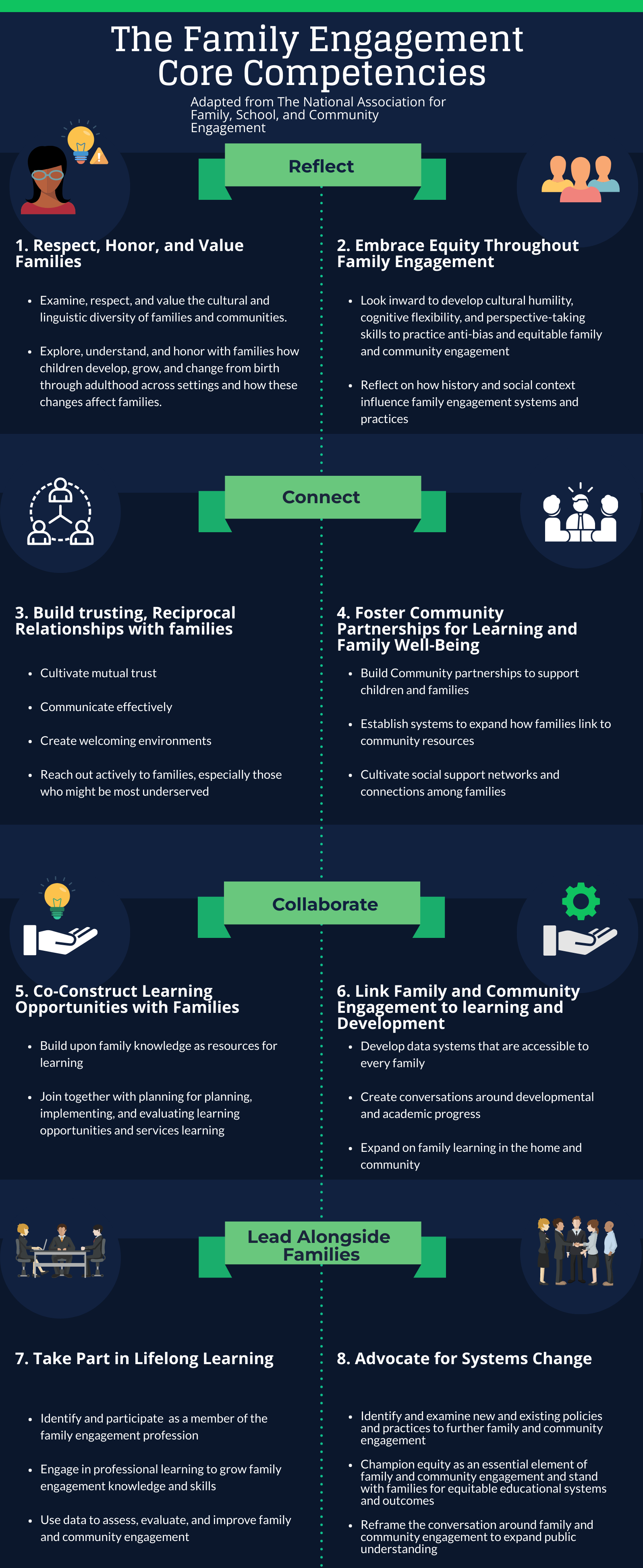Family Engagement Core Competencies
According to the National Association for Family, School, and Community Engagement, “the purpose of the Family Engagement Core Competencies is to create a nationally agreed upon and unifying set of professional competencies for the family engagement field.” It contextualizes the role of bias, stereotypes, equity, and social justice in family engagement and strives to honor funds of knowledge, equitable processes, cultural humility, and trust. The National Association for Family, School, and Community Engagement challenges family-facing professionals to self-reflect on their own practices and beliefs as they relate to the four domains of the core competencies:

Family-Facing Professional’s Reflection Tool
The Family Engagement Core Competencies from the National Association for Family, School, and Community Engagement created a self-reflection tool that outlines research-based and effective strategies for working with families in ways that are culturally relevant, honors funds of knowledge, and center around true collaboration:
| Reflection Questions | Proficiency | Ways to Improve |
| How do I respect, value, and honor families?
Ask yourself: In what ways do I respect and value the cultural and linguistic diversity of families and communities? How do I understand and honor families regarding how children develop, grow, and change from birth through adulthood across settings, and how might these changes affect families? |
1 2 3 4 5 | |
| How well do I champion equity through family and community engagement?
Ask yourself: How do I demonstrate cultural humility? How do I utilize cognitive flexibility, and perspective-taking skills to practice anti-bias and equitable family and community engagement? In what ways do I see history and social context influencing family engagement systems and practices? |
1 2 3 4 5 | |
| How well do I build trusting reciprocal relationships with families?
Ask yourself: In what ways do I cultivate mutual trust with families? How do I communicate with families? How do I create welcoming environments? In what ways do I reach out to families, especially those who might be most underserved? |
1 2 3 4 5 | |
| How well do I foster community partnerships for learning and family well-being?
Ask yourself: What are the community partnerships that support children and families? How do I expand ways for families to access these resources? How am I cultivating social support networks and connections among families? |
1 2 3 4 5 | |
| How well do I co-construct learning opportunities with families?
Ask yourself: How do I build from family knowledge as resources for learning? How do I join with families in planning, implementing, and evaluating learning opportunities and services? |
1 2 3 4 5 | |
| How well do I link family and community engagement to learning and Development?
Ask yourself: How do I ensure that data are accessible to every family? How do I create conversations around developmental progressions and academic progress in clear and understandable ways? How do I expand on family learning in the home and community? |
1 2 3 4 5 | |
| How well do I take part in lifelong learning?
Ask yourself: How do I identify and participate as a member of the family engagement profession? How do I engage in professional learning to grow my family engagement knowledge and skills? In what ways do I use data to assess, evaluate, and improve family engagement practice? |
1 2 3 4 5 | |
| How well do I advocate with families for system change?
Ask yourself: How do I identify and examine new and existing policies and practices to advance family and community engagement for all families? In what ways do I champion equity in my family and community engagement practice? How do I help reframe the conversation around family and community engagement to expand public understanding? |
1 2 3 4 5 |
Pause to Reflect!
Discuss the following questions.
- Rate yourself in the Family-Facing Professional’s Reflection Tool.
- Based on what you have learned from your reading, identify ways that you can develop and improve in your collaborative work with children, families, schools, and communities.
Media Attributions
- Family Engagement Core Competencies © ROTEL adapted by National Association for Family, School, and Community Engagement is licensed under a CC BY-SA (Attribution ShareAlike) license

